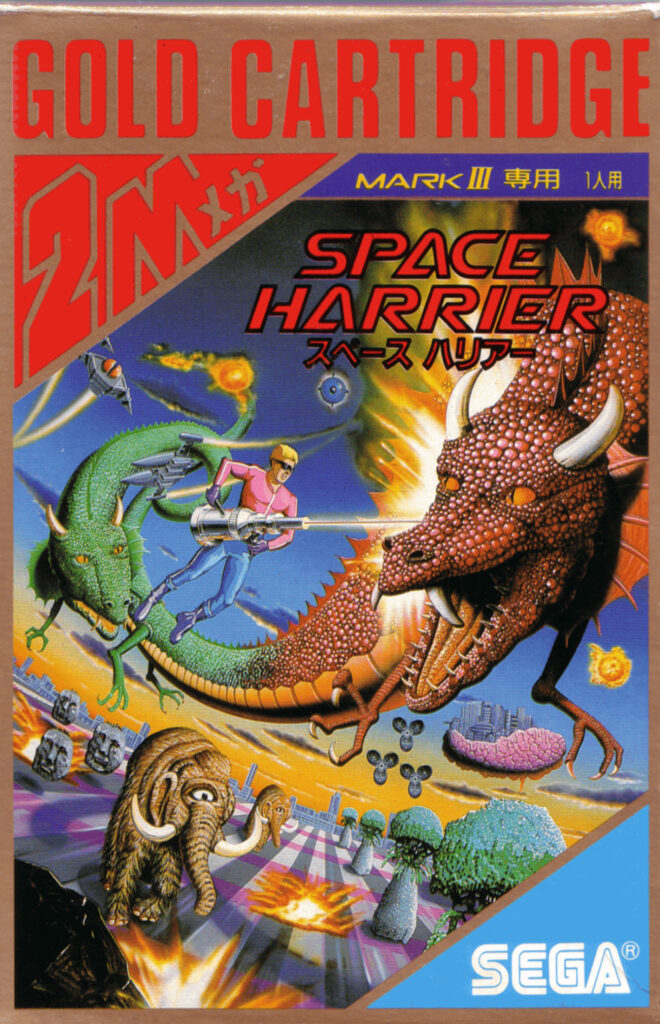
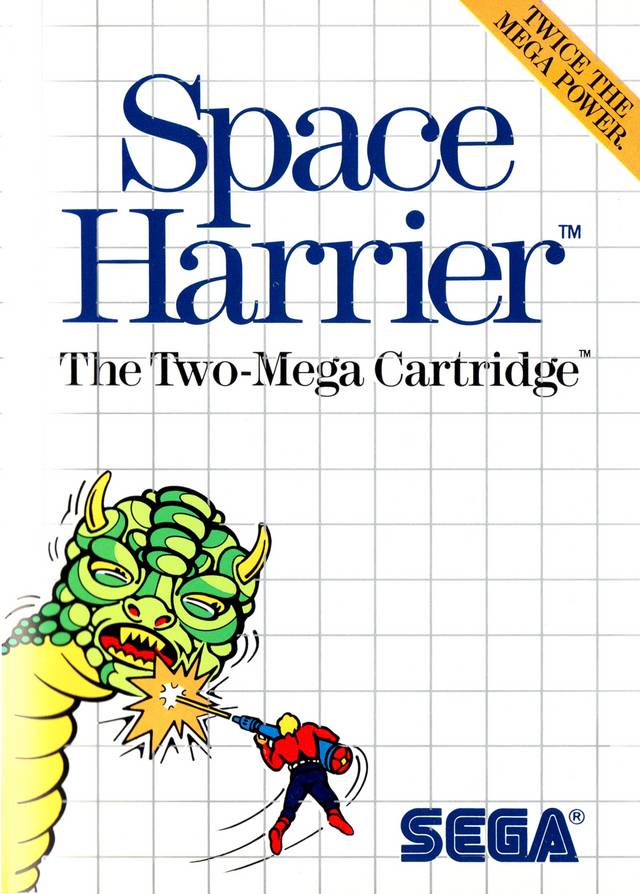
PLAYERS: 1
PUBLISHER/DEVELOPER: Sega
GENRE: Shooter
RELEASE DATE: 12/21/86 – (JP), 03/87 – (US), 08/87 – (EU)
ALSO ON: Game Gear, 32X, Saturn (proper reviews coming soon)
Crappy graphics and choppy framerate be damned: the Master System port of Space Harrier is determined to win you over through its relentlessness. You’ll be too busy shooting Olmec Heads and swooping jets to notice that the trees and rocks you’re sailing past look like cardboard cut-outs. The first boss, a fire-breathing dragon, has a horrible flame attack that stutters at around 5 frames-per-second through the sky toward you. But, if you’re like me, you’ll continue shooting at him regardless of how slow his flame moves, because the game trains you to keep going. Indeed, Space Harrier‘s ability to look crappy and decrease to a slow chug while simultaneously keeping an all-around steady momentum is one of gaming’s great mysteries – one that I was determined to solve by playing the game over and over, despite the fact that I didn’t care for it.

In Space Harrier, you play as a jetpack-wearing renegade named The Harrier, whose shooting his way across the Fantasy Zone (yes, that Fantasy Zone). with nothing but a blaster and his soon-to-be-empty flask. The game is a third-person rail shooter, among the first of its kind. You control the directional movements of the Harrier, but you don’t control his speed, so you’re constantly moving through, dodging, or shooting the limitless amounts of crap the game throws at you without the ability to stop or even slow down. Each zone has airborne enemies – usually jets or mechs that swoop in, unload some rounds, and leave – and ground obstacles, like rocks, trees, or fantastical structures. Some of the ground obstacles, particularly those that look like buildings, can’t be shot down, but all of them can be run into by the Harrier. The best strategy for navigating the eighteen zones of Space Harrier is to never stop shooting or moving. Also, Down+Left+Button 1 at the Game Over screen. Happy Thanksgiving.
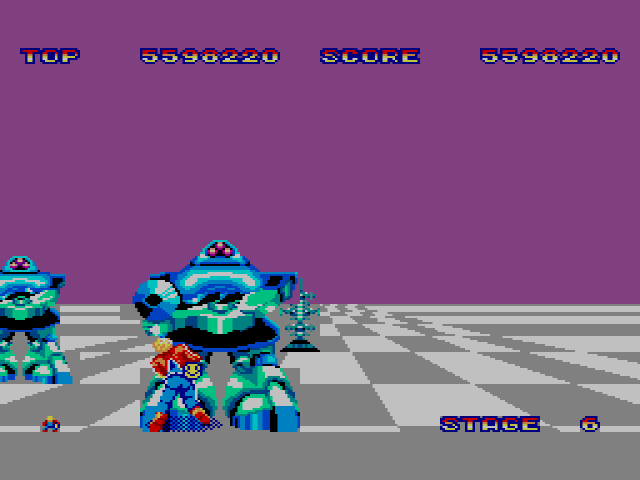
Space Harrier‘s aggressive difficulty stems both from its technical limitations, and the fact that it’s an arcade port from the mid-80s, so of course it’s tough. Navigating the Harrier around the game’s overwhelming and fast-moving panorama will literally make your eyes water from time to time. Unlike the detailed, beautiful arcade version, there are no backgrounds, just colored checkered floors that scroll along blindingly as the Harrier soars through the level. The Harrier and the enemies move fast enough, but the same can’t be said for the enemies’ projectiles. While the projectiles are large and globular (all but impossible to miss), they never move as quickly as the rest of the in-game action, making it difficult to tell which direction they’re headed. Many of my deaths came from the inability to discern the movement of the projectiles, while the remaining deaths came from my inability to steer the Harrier around buildings and projectiles and mechs, all at the same time. I blame his empty flask.
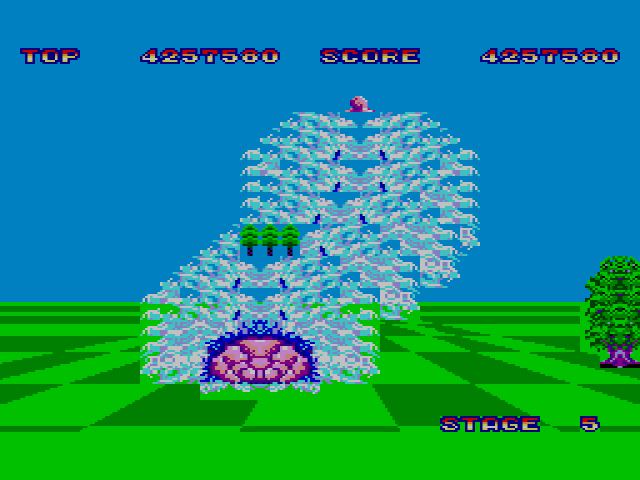
As a port, Space Harrier is ambitious. Attempting to distill the Super-Scaler technology of the arcade version into a large-for-the-day two-meg cartridge is no small feat. While I’d like to say that the Master System version accurately replicates Space Harrier as a whole, the port really does feel compromised. All eighteen levels from the arcade have been recreated, but because of the lack of backgrounds and missing colors, they run together in a rush of poorly rendered neon (this might be the first time I’ve been unimpressed with the Master System’s graphics). The core game is present – you still fly and shoot at the same time – but I was never absorbed into the alien worlds as I was with the arcade version. The aforementioned cut-out graphics might have something to do with it. I didn’t have time to dwell on them while I was playing, but upon reflection, they look absolutely ridiculous in action.
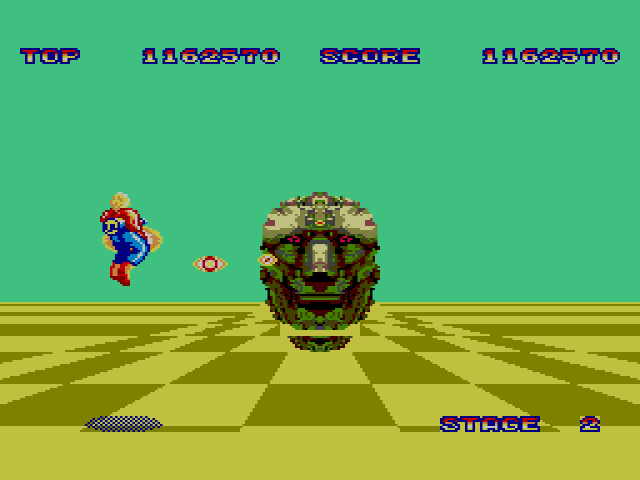
As a port, Space Harrier should have been given better care, but I still don’t blame Sega for releasing it. Like Nintendo in the early 80s, Sega’s clout in the mid-80s came from their arcade games. Space Harrier was a brand-new gaming experience: from the third-person on-rails shooting, to the mind-blowing scaling, to the rollicking sit-down cabinet, and even the digitized speech (“Get ready!”). Sure, at the game’s core, it was just a shooter, but it was one of the most immersive shooters made up to that point. As a result, Space Harrier was incredibly successful in the arcades, which made it a no-brainer for porting it to Sega’s beleaguered Mark III/Master System. Unfortunately, like Alex Kidd before it, the game did little to boost the console’s favor. One could blame it on the port’s overall shoddiness, but in reality, even if Space Harrier was arcade-perfect, Nintendo’s brilliant marketing and ever-increasing console sales overshadowed anything Sega tried to do to combat it. Given that the game hasn’t aged gracefully, it’s probably for the best that Space Harrier didn’t put Sega on the console-winning map.
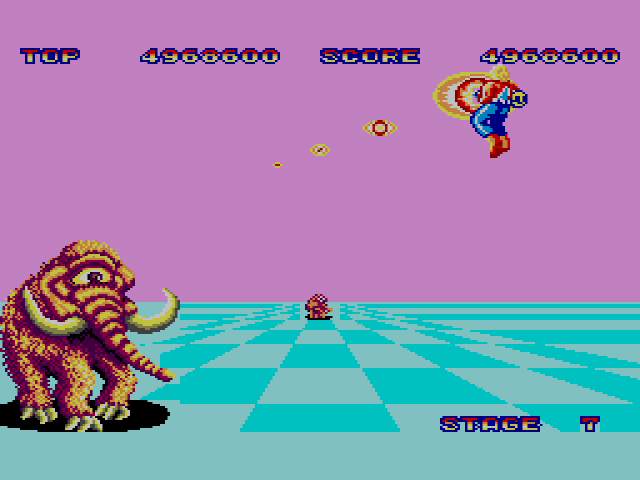
Despite my issues, Space Harrier is playable and borderline addictive; the quick transitions between levels give you little time to think about whether the game is worthy of your time or not. Also, shooters tend to hook me, regardless of difficulty or amount of enjoyment I find in them. That being said, unless you’re feeling nostalgic for stunted ports, there’s absolutely no reason to return to this chopped and screwed Master System version.
C

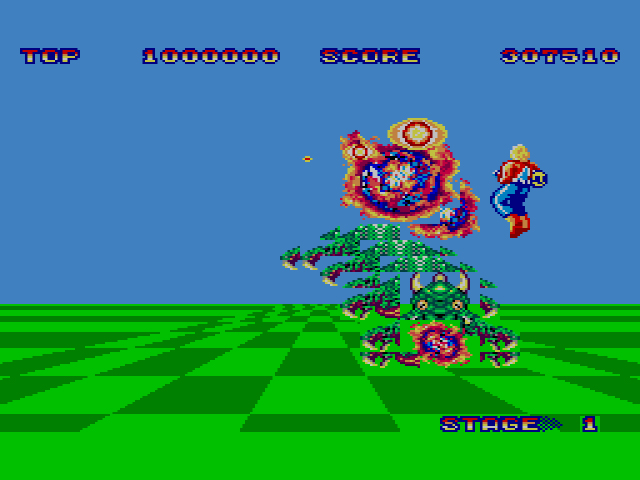
9 replies on “Space Harrier (Master System, 1986)”
I don’t want to say too much but I really liked this game. One for the time the graphics looked great, the enemies like the Jets and mushrooms were highly detailed and colorful. Only compared to the arcade was it inferior. And two like you said this game played great. It was challenging and a lot of fun. I usually judge how good a console port is by if I can master the home version and then translate those skills to the arcade. With Space Harrier I was able to beat the arcade version after mastering this one. Third the music was great. I just loved the music in this game. I liked this better than Space Harrier 2 on the Genesis. This game also added a last boss. Though you wouldn’t want to play this version today. The best version is the 3D arcade version on the 3DS. They even added the SMS last boss into the arcade version. For me this was a B+. There was nothing wrong with the mechanics and fun of this game. I can’t downgrade it for the graphics.
I will say, I played the arcade version after I played the Master System version and I felt like a champ. The Master System version is definitely more difficult, but I think that’s because of the technical limitations. It’s not just the graphics, it’s how the game slows during intense areas – which, towards the end of the game, is just about everywhere.
You obviously didn’t play as the jet otherwise this review would have done a 180 to Having A Blast Land
And what about the easter egg where if you fill the top score places with the name of the initial top score thats preloaded you get to the screen that tells you to bust out a piece of paper and write to SEGA to get free stuff?
http://www.smstributes.co.uk/eastereggs/spaceharrier.gif
I’ve never played the Master System version and to be frank after reading this I don’t want to. I will promise you though the 32x and Saturn versions are both awesome !
You know the port has issues when it can’t render a proper Olmec. Someone should have given Sega this for reference:
http://rumyrashead.com/wp-content/uploads/2013/09/almenac.jpg
But seriously, no home system could even hope to properly emulate the Super Scaler technology until the 32X.
When I see this picture, I think “I love you, Dr Zaius!”
If I sound delusional, and I probably do, its because I played Space Harrier on SMS til i beat it and loved every second of hanging in there and “doing great”. It is pretty hard and I know it is nowhere as great looking as the arcade. People do frown upon this port for good reason. The original arcade machine is a thing of beauty and illusion of 3D that really was not in arcades before Yu Suzuki and Sega built this. You did a great review, no question of it. I just appreciate this game so much. It was like a f*ckin menagerie of space beasts were charging weapons and coming at my blonde football player dude (Flash, A-AAAAA) and I needed to shoot my way through to Wi Wi Jumbo and defeat his ass. The game is still one of my fondest memories of the Master System and gaming. Around a month after I got it, I had a marathon session on it and had my roommate pause it (pause was on the console, dam you Sega) at certain points so I could draw small sketches of some of the enemies. I really got into the game. Since most of the creatures are really strange looking (yes, Snuffluphagus, you are not alone) and the world races at a quick clip some of the details are a blur. When I finally did beat Space Harrier I was so happy and got that accomplished feeling (thumbs could finally rest). I was treated to my first ending sequence, which opened a whole bunch of possibilities that all games should have grand finales. Space Harrier has really decent music, too. “Lakeside Memories” is a pretty great tune and one that has made me wonder what could make our hero experience such melancholy. It helps place this game near my favorite of that generation. Yes, it is pretty limited, and flickers more than anyone would like it to, but from title screen to high score screen this game does a decent job.
This story almost makes me want to give the game another chance… almost. Thanks so much for sharing!